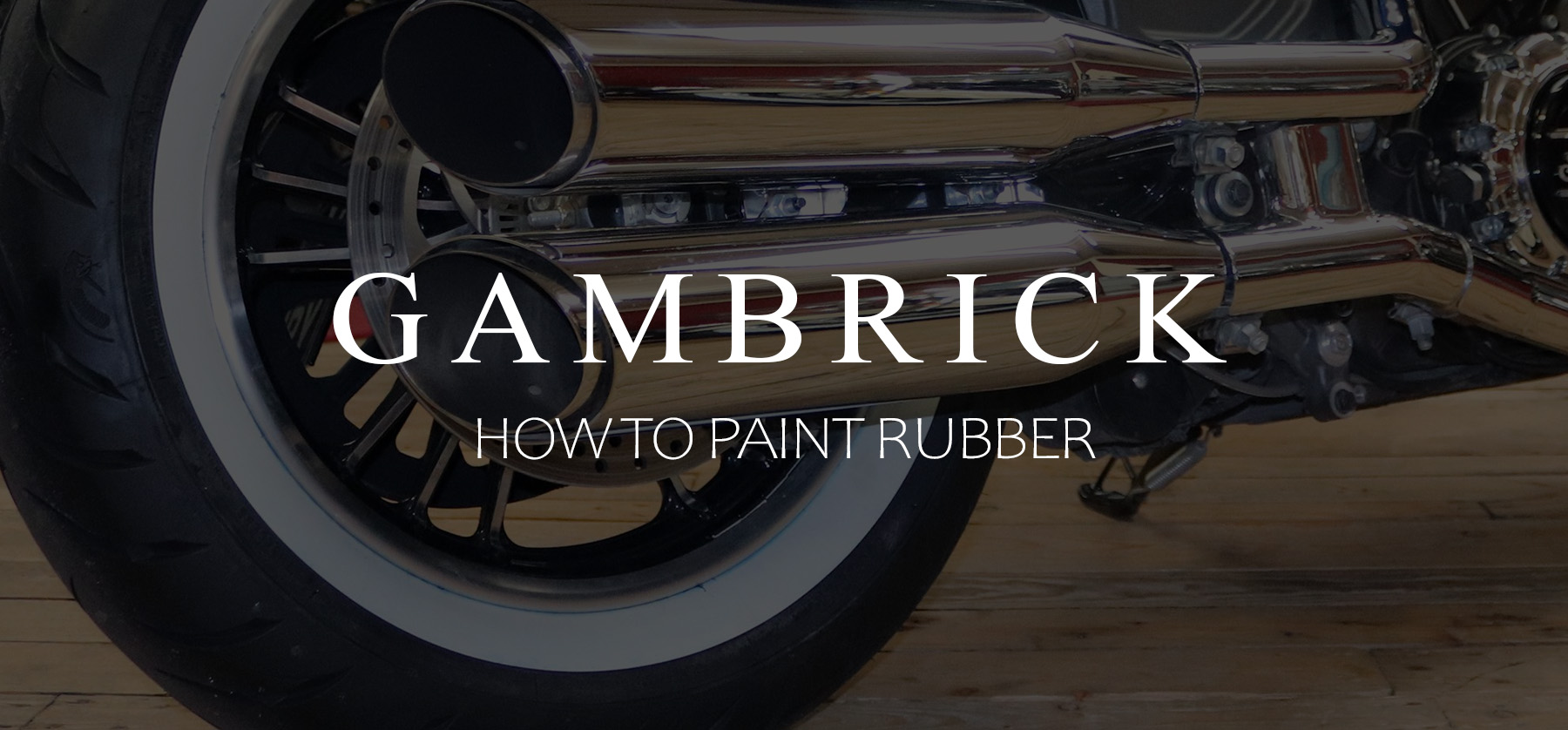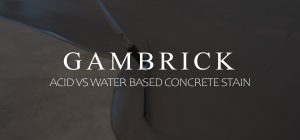How To Paint Rubber
Rubber is a relatively easy material to paint on. There are many types of rubber and almost all can be painted. However, you have to use the right type of paint for the kind of rubber you’re painting. You can’t use just any paint on a rubber surface or it could flake, peel, fade or crack. Rubber is a flexible material that expands, contracts, stretches and bends. So the paint you use not only has to stick to the surface but also be flexible. If the paint can’t flex with the rubber, it will crack and eventually fall off. How to paint rubber is actually very easy, the paint can be applied with a brush, roller, sponge or sprayer. Apply 2 thin and even coats. Many paints work best if you also apply a primer first and sealer on top.
- First, make sure the rubber is clean of any dirt, debris, grime, grease, oils, dust, etc. Foreign substances can prevent paint from sticking.
- Next, prime the rubber. Primer helps paint stick. Make sure to use a flexible primer that can flex without cracking.
- Finally, apply the paint with a roller, brush or sprayer.
- 2 Thin coats of primer and paint are generally best.
- Apply paint evenly in thin coats until you can’t see the rubber below.
Before you paint, identify the type of rubber you’re painting. Then find a primer and paint that works best. If you can’t determine what type of rubber it is, test different paints on a small area to see what works best.
In this article, we’ll discuss how to paint rubber and the best paints for rubber. We’ll also go over some tips on how to apply paint to rubber and list the supplies you’ll need to get the job done right.
Can You Paint Rubber?
Yes, rubber is actually very easy to paint, however you have to use the correct type of paint. Rubber is a flexible material that expands, contracts, stretches and bends. So you need a paint that can move with the rubber. If the paint is too stiff it will crack and peel when the rubber moves.
Not all paints will stick to rubber, you need a paint that’s flexible with good adherence.
These include:
- Acrylic
- Removable
- Exterior Grade
- Marine
Rubber is durable, weather resistant, flexible and very easy to mold and shape. This makes it a great material for all sorts of products which includes car tires, floor mats, shoe soles, pacifiers, door stops, hoses, balls, toys and many more. Many of these items are then painted and sold with a variety of prints and colors.
Painting rubber is possible when you use the right paint and prepare the item properly. This includes cleaning and drying the material before you start painting. A primer is often also used to increase durability and adherence. After the item dries you can also add a sealer to increase durability and UV resistance.
There is a wide selection of paints that will work based on the type of rubber you have. Make sure to choose the right paint for the rubber you’re painting. If you choose the wrong paint, it will eventually crack, peel and chip.
Paints can be applied to rubber using a sprayer, roller, brush or sponge. Apply multiple thin and even coats. Make sure the paint is dry before applying the next coat.
The Best Types Of Paint For Rubber
It’s fairly easy to paint rubber, but you need to use the right type of paint because not every paint will work. This is mainly due to rubber’s flexibility. Some paints do not flex enough which causes them to crack, peel, chip and flake off.
In this section, we’ll discuss the best types of paint for painting rubber.
Acrylic Paint Works On Rubber
Acrylic paint is a very popular type of craft paint that bonds well to a wide variety of materials which includes rubber. Because it doesn’t have the best durability, acrylic paints are best used indoors on items that won’t get much wear and tear or handling.
- For best results, make sure the item is clean and dry before you paint.
- Apply at least two thin coats of paint.
- Acrylic paint can be applied with a sprayer, brush, roller or sponge.
- Make sure each coat is dry before applying the next.
- Apply a clear sealer to increase the paint’s durability and UV protection.
Acrylic paint comes in a wide variety of colors and you can mix your own if you can’t find the perfect shade.
Removable Paint For Rubber
If you only want a temporary coat of paint then consider using removable paint. These paints are excellent for projects that only need color for a short time. For example, if you’re painting to celebrate a holiday, birthday, special event or sport, removable paints allow you to change the paint job with every occasion.
It’s generally sold in a can of spray paint either online or at home improvement or paint stores. Once dry, it can be easily removed simply by peeling it from the rubber.
- Removable paint works great on a variety of rubber surfaces.
- Flexible and highly durable.
- Does not chip, flake or peel.
- Great for short term festive decorations.
- Easy to use.
- Make sure the rubber is clean and dry before painting.
- Does not require a primer.
Removable paints are great for short term decorations or to try out different color schemes. If you don’t like the paint job, simply peel it off and try again.
Exterior Paint Works On Rubber
Exterior paint works really well on rubber. It’s flexible, sticks to a wide variety of materials and is designed for toughness. Durability is very important when painting an outdoor item. Exterior paint is specially made to resist things like weather, water, temperature fluctuations, UV rays, wind, snow, ice, sand, dirt, abrasions, etc. This is very important because outdoor rubber will see a lot more wear and tear.
- Exterior paint can be applied with a paintbrush, roller, sponge or sprayer.
- For the best results, make sure the rubber is clean and completely dry before you paint.
- Apply a primer before painting.
- 2 Thin coats of primer and paint generally works best.
- Primer makes it easier for the paint to adhere and increases durability.
- Exterior paint is great for painting things like car and bike tires or rubber boots.
- Exterior paint can be sealed to add even more protection.
The rubber should be very clean and dry before you paint. Coat it with an exterior primer before painting to make the paint adhere better and increase durability. 2 thin coats of primer and paint generally work best.
Make sure each coat is dry before applying the next.
Marine Paint For Rubber
Commercial grade marine paint is fantastic for painting rubber. It’s extremely durable, weather resistant and won’t crack, peel or fade when exposed to UV rays. It’s also a very thick and sticky paint with great flexibility that adheres well to a variety of surfaces.
Marine paints are designed to be durable and resistant to the elements. They’re used on things like boats, swimming pools and spas. A high quality commercial-grade marine paint will have no problem bonding to rubber and provides a flexible coating that will last for years.
- Make sure the rubber is clean and dry before you start painting.
- Marine paints do not require priming or a sealer.
- The paint is thicker than standard paints and more flexible which makes it great for rubber.
- Apply the paint using a brush, roller, sprayer or sponge.
- 2 Thin and even coats is usually best.
- Make sure the previous coat is completely dry before applying the next.
Marine paint resists peeling, chipping, fading and is very flexible which makes it a great choice for painting exterior rubber surfaces. It’s also 100% waterproof so you can even paint rubber parts that come in direct contact with or become submerged in water.
The Best Paint For Hard Rubber Is Spray Paint
Spray paint is by far the best product to use on rubber. A sprayer applies paint in thinner, more even layers compared to brushes or a roller. Cans work great but for the best possible results use a mechanical sprayer. I recommend sprayers made by Graco.
- Make sure the rubber is clean and dry.
- Apply spray paint in several thin layers.
- If you use a can, look for one with a no special cap that prevents blotches.
- Keep the can about 6 to 8 inches away.
- Move the can as you spray to avoid building up paint in a single area.
- Always spray in several even thin coats.
- 2 to 3 Coats are generally enough. But feel free to use more if necessary. The thinner the coat the better.
- Wait for a coat to dry before applying the next.
- Use a primer for even more durability and adherence.
If you use a spray can, try Krylon’s Master Paint and Primer. It contains a built-in primer which makes the process of painting rubber that much simpler. The paint is durable and comes in a wide variety of colors. But be aware that it’s smelly and flammable so be careful where you use it and make sure the area is well ventilated.
- It has a quick-drying formula.
- Provides great coverage.
- Works indoors and outdoors.
- Dial tip for adjustable spraying.
- Dries in 10 minutes or less.
If you’re using a mechanical sprayer instead of a can, I recommend painting and priming separately instead of using a two-in-one product. This gives you more control over the paint job.
Spray paint for rubber is easy to apply but works best if the rubber is firm. If you’re painting flexible rubber you should use a marine grade paint instead because it’s thicker and has more flexibility.
The Best Paint For Flexible Rubber Is Marine Grade
Marine grade is the most durable, waterproof and flexible paint you can use on rubber. This makes it an excellent choice if your rubber is outdoors, will be submerged in water or is flexible. It’s a thick paint that does not require a primer or a sealer. Simply brush, roll or spray it onto a clean and dry rubber surface.
Marine paint resists wind, rain, UV rays, temperature fluctuations, abrasions, cracks, peeling, flaking, etc.
One-part polyurethane marine grade paints are generally best because they’re very easy to use and don’t require mixing different components together. Simply open the can, stir and start painting.
The best way to apply marine grade paints to rubber is with a sprayer. A mechanical sprayer applies paint in thinner, more even and consistent layers. However a brush or roller works fine too.
Apply several thin and even coats. Do not try to coat a material in a single thin coat. Always make sure the previous coat is dry before applying the next. 2 Coats generally works best but feel free to apply more as needed.
More thin coats of rubber paint are always better than less thicker ones.
Marine grade paint can be used on both rigid and flexible rubber surfaces.
The Best Paint For Indoor Rubber Is Acrylic
If you’re painting rubber that’s indoor and won’t be handled often the best paint to use is acrylic. It’s super easy to mix and apply, comes in tons of colors and works with a brush, sponge, roller or sprayer. Acrylics are the most common type of paint used for arts and crafts because they’re cheap, easy to use and very versatile. But they’re not very durable so they shouldn’t be used outdoors or handled often.
Acrylics work best if you apply some primer first. The primer helps paint adhere better and provides more durability.
For even more durability or if you plan on handling the rubber, apply a coat of sealer at the very end. Sealers provide more durability and UV protection. They also help prevent scratches, chips and flaking.
- Make sure the material is clean and dry before you paint.
- 2 Coats of primer helps the paint adhere and provides more durability.
- The best way to apply acrylics is with a sprayer. They apply paint in thinner, more even layers.
- Mae sure the previous coat of primer or paint is dry before you apply the next.
- Rollers and brushes work really well too.
- Use some painter’s tape to mask off areas you don’t want paint.
- A sealer can improve acrylic paint’s durability and UV protection.
Acrylic paints are very popular for doing arts and crafts so they’re affordable and easy to find. You can buy them online, at many department stores or art stores like Michael’s. I’ve even seen them sold at super markets and pharmacy’s like CVS.
How To Paint Rubber Step By Step
Painting rubber is a fairly easy process that’s done with standard tools like a roller, brush, sponge or sprayer. Make sure you use a primer and paint that are appropriate for the type of rubber you’re painting.
Here are the steps you need to follow:
- Thoroughly clean the rubber of any dirt, dust, debris, oil, grease, grime, etc.
- Make sure the rubber is completely dry.
- Choose a paint that works on the type of rubber you’re painting.
- Apply an exterior primer when able. If you’re painting exterior rubber this is an important step because it helps the paint stick and prevents cracking. However it’s not necessary if you’re using marine or removable paints.
- 2 Thin and even coats of primer are generally best.
- The primer must be completely dry before applying the next coat.
- When the primer is completely dry, start painting.
- 2 Thin and even coats of paint generally works best.
- Apply as many coats as needed until you can no longer see the primer or rubber colors below.
- A paint sealer can be applied after the paint has dried to further waterproof and protect the color. Sealers increase durability and add more UV protection.
Will Paint Adhere To Rubber?
Yes, paint will adhere to rubber as long as you use the right type of paint and follow the correct process. Here’s a breakdown of what you need to do:
- The rubber must be completely clean and dry before you start painting.
- Use a primer if necessary depending on the type of paint your using. Acrylics and exterior paints work better with a primer. Marine grade and removable paints do not benefit from priming.
- Apply 2 thin and even coats of primer using a brush, roller, sponge or sprayer.
- Allow coats to completely dry before applying another coat.
- When the primer dries start painting.
- Apply rubber paint with a roller, brush, sponge or sprayer.
- 2 Thin and even coats generally works best. But feel free to apply more coats as needed.
- Wait for each coat to dry before applying the next.
- Once the last coat dries, apply a sealer for even more durability and UV protection. This is beneficial for acrylic and exterior paints but not removable or marine paints.
Tips For Painting Rubber
- Spray paints are the best way to paint rubber. They apply paint thinner and more even than brushes or rollers.
- Rubber coatings can be used to fill cracks, leaks, and small holes in rubber items.
- Please read all directions carefully before working with any products.
- Some paint brands include primer as part of the paint, so you can paint and prime at the same time. I prefer doing is separately so I can be sure each step is done properly.
- Before painting rubber, make sure that it’s clean and free from any oils, grease, dust, dirt, etc. Soap and water is usually enough to get the surface clean.
- The rubber should be completely dry before applying primer or paint.
- When painting firm rubber items, like a car tire, use sandpaper to roughen up the surface a bit and remove gloss or residue. This will improve the bond of the paint or primer.
- Selecting the correct paint is crucial.
- Use painter’s tape to mask off areas you don’t want painted. This is very helpful when painting car or bikes tires. I recommend using Frog tape.
How To Paint Rubber Tires
One of the most common rubber items that gets painted are car, truck and bike tires. Black tires with white lettering or white walls is a very attractive and popular look. Painted tires also make a great yard swing or planter. Using old tires for a new purpose is a great way to recycle which keeps them out of a landfill.
Rubber tires are only slightly flexible which makes them easy to paint. Use a high-quality exterior paint that’s durable and weather resistant paired with an exterior grade primer.
- Clean the tires thoroughly of any grease, grime, dirt, oil, dust, etc.
- Make sure the tires are completely dry.
- Use painter’s tape to mask areas you don’t want painted.
- Apply 2 thin and even coats of primer.
- Wait for each coat of primer to dry before applying the next.
- Apply at least 2 thin and even coats of paint.
- Wait for each coat of paint to dry before applying the next.
- Apply a layer of sealant to add more durability and UV protection.
- Remove the painter’s tape.
Clean The Tires Before You Paint
Make sure the tires are clean of all grease, oil, debris, dirt, sand, residue, etc. If you paint a tire with any substance on them it can prevent the paint and primer from adhering properly. Warm soapy water is generally enough to remove most substances. But if you need something stronger use a store bought tire cleaner.
Use a bristle brush to remove any substances from the within the treads.
Finally, rinse the tires of all soap or cleaner residue and let them dry.
Priming & Painting
Once the tires are clean and dry, use painter’s tape to mask off areas you don’t want paint. Using a medium to coarse grit sandpaper to sand down the tires can help with adhesion. This is especially beneficial if the tires have a glossy shine.
If you sanded the tires, use a tacky cloth to remove the dust.
The tire should be completely dry before you apply the primer.
Apply at least 2 thin and even coats of exterior grade primer with a brush, roller or sprayer. Let the first coat of primer dry before applying the next.
Let the primer dry before applying at least 2 thin and even coats of paint. use a roller, brush, sponge or sprayer to apply the paint. A sprayer generally works best for painting rubber. Allow each coat of paint to dry before applying the next. Feel free to apply more than 2 coats if necessary. More thin coats are better than fewer thick ones.
Once you’ve completed painting, consider adding a sealer coat on top. A sealer will increase the paint’s durability and UV protection.
Allow the paint time to cure before using the tire.
How To Paint Rubber Boots
Rubber boots are a very popular footwear that pretty much everyone has a pair of. They’re great to throw on when you don’t want to get your good shoes soaking wet in a rain storm. Painting rubber boots is very easy to do and makes a fun project if you have an old pair lying around.
Rubber boots are flexible so you need a flexible paint and primer that can flex with the boot. And because rubber boots are designed to get wet, you need a water resistant paint.
Use a high-quality exterior paint that’s durable and weather resistant paired with an exterior grade primer.
- Clean the boots thoroughly of any grease, grime, dirt, oil, dust, etc.
- Make sure the boots are completely dry.
- Use painter’s tape to mask areas you don’t want painted.
- Apply 2 thin and even coats of primer with a spray can or mechanical sprayer.
- Wait for each coat of primer to dry before applying the next.
- Apply at least 2 thin and even coats of paint with a spray can or mechanical sprayer.
- Wait for each coat of paint to dry before applying the next.
- Apply a layer of sealant to add more durability and UV protection.
- Remove the painter’s tape.
You can also use a two in one exterior paint and primer in one.
Clean and Prep the Rubber Boots
Clean the rubber boots thoroughly before doing any priming or painting.
Any grease, oil, dirt, grime, etc. will prevent the paint from adhering properly. Use warm soapy water and a coarse bristle brush to scrub the boots and treads. Once they dry, use medium to coarse grit sandpaper to scuff the surface of the rubber which removes the gloss. This will help your paint bond better with the rubber.
Use a tack cloth to clean off any dust created by sanding.
Cover any areas you don’t want painted with painter’s tape. I recommend using Frog tape. It has a special edge that reduces bleed.
Spray Painting Rubber Boots
Spraying is the best way to paint rubber boots. You can use either a spray can or a mechanical sprayer. I recommend using Krylon spray paint or a Graco brand sprayer.
Make sure to use an exterior grade paint and primer. Rubber boots are flexible and get wet so you need a flexible, weather resistant paint.
- Shake the can until the metal agitator is moving freely. When the paint is mixed you’ll hear the agitator rattle back and forth. This usually takes about 2 to 3 minutes. This ensures that the spray paint and propellant have been sufficiently mixed.
- Buy a spray can with a tip that prevents blotches.
- Stand your rubber boots up on some old newspaper or a drop cloth.
- Spray paint gives off a strong odor so make sure to paint somewhere with good ventilation.
- Hold the can about 8 inches from the boot and spray in short controlled bursts while moving the can side to side or up and down. Don’t stop and spray because too much paint will accumulate in one spot creating drips. Spray in very thin coats.
- It’s better to apply multiple thin coats than a single thick coat.
- Wait for the previous coat of paint to dry before applying the next.
- Continue to spray very thin coats until the entire boot is covered.
The process for spraying rubber boots with a sprayer is exactly the same as with a can.
Many Rubber Products Are Painted
Lots of consumer products contain rubber that’s painted at the factory. From shoe soles to toys, boats, floor mats, hoses, car tires and many, many more. Rubber is a very versatile material that’s easy to shape into just about any form, flexible, durable, weather resistant and extremely tough.
Rubber can be extruded, injection-molded, or rolled into sheets and cut into a variety of shapes. It’s then used to make a wide variety of products that we use every day.
There are two main types of rubber, natural and synthetic.
- Natural rubber is found in nature and grows from a Tropical rubber tree.
- Synthetic rubber is made in a factory.
Before the rubber is sold in stores, it’s typically primed and painted at the factory. The white writing on car tires, shoe soles and floor mats are all examples of painted rubber.
Over 30 million tons of both synthetic and natural rubber are used every year in the United States. More than two-thirds of this is synthetic. Luckily, rubber is recyclable so old products can be re-used instead of ending up in a landfill.
Natural Rubber
Natural rubber comes from a South American Tropical Tree nicknames The Rubber Tree because it produces rubber. A milky sap-like liquid can be drained from cuts in the tree’s trunk. When it dies, the milky substance forms into natural latex rubber.
- Trees can yield about a cup of latex rubber every two days.
- The latex rubber is processed and compacted into bricks or rolled into sheets and shipped.
- The rubber is smoked with natural fungicides to prevent mold growth.
Natural rubber is used to make a wide range of products such as shoe soles, toys, surgical gloves, pacifiers, boots, door stoppers and car tires.
Synthetic Rubber
Synthetic rubber is made from crude oil. It comes in many different forms which is determined by the chemical manufacturing processes. The most common types of synthetic rubber are butyl, acrylic, ethylene-propylene, styrene-butadiene, and silicone rubbers. Each has its own pros vs cons and best uses.
Synthetic rubber is used to make a wide range of products such as shoe soles, boots, door stoppers, mallets, hoses and car tires.
Properties
Rubber has a variety of properties which vary based on how it’s manufactured and what additives are used. It can be made resistant to extreme weather and temperatures, abrasion, chemicals, oils and impact.
- Rubber can be soft and very flexible or extremely hard and dense.
- It’s naturally a very tough material that’s flexible and resistant to impacts.
- Because of rubber’s wide range of properties, it’s a very versatile material.
- The type of paint you can use on rubber is effected greatly by its material properties.
- The more flexible the rubber, the more flexible the paint and primer need to be.
Even though it’s fairly easy to paint rubber, you need a paint and primer than can flex. All rubber is flexible to different degrees. The paint you use has to match the flexibility of the rubber you’re painting.
If you use a paint that can’t flex, it will eventually crack, peel or flake off.
Hard rubber that doesn’t flex much, like car tires, floor mats or shoe soles, is easier to paint than highly flexible rubber.
The more flexible the rubber, the easier paint cracks or flakes off when it moves. Paint on hard rubber is less likely to crack, but it’s more prone to peel or wear off over time. Using the right type of paint and primer helps it adhere and increases durability.
FAQs On How To Paint Rubber
Here are some commonly asked questions about how to paint rubber.
Can You Paint Rubber With Any Type Of Paint?
Yes and no. Any type of paint can be used on rubber, but they won;t all be effective. You need a paint and possibly a primer that will both adhere to the material and flex as it moves. Rubber is a naturally flexible material that bends, stretches, expands and contracts. So the paint and primer have to be flexible too. If you use the wrong product it will typically crack, fade, peel or chip off.
- Acrylic paint is a great paint for rubber if it’s used indoors. But it doesn’t have much durability so I don;t recommend using acrylics outdoors. However you can apply a sealer on top that increases durability and UV resistance.
- Exterior paints work really well if your material is outdoors. They have better UV protection and more durability than acrylics.
- Both acrylic and exterior paints benefit from a primer.
- Removable paints work great on rubber and can be removed. They’re more of a short term coating than a true paint.
- Marine grade paints are the best for rubber. They’re extremely durable, waterproof and very flexible.
How Do You Apply Acrylic Paint On Rubber?
Acrylic is best for painting indoor rubber. Apply at least two thin and even coats with a sprayer, roller, brush or sponge. A mechanical sprayer usually works best. Because acrylics are not that durable, they benefit from a primer and a sealer. Apply two coats of primer before you start painting and a single coat of sealer when you’re done.
Clean the material thoroughly before you start painting.
Make sure the previous coat of primer or paint is completely dry before you apply another coat of any substance.
What’s The Best Primer For Rubber?
The best primer for rubber is exterior grade. Exterior grade products are more durable, have better weather protection and more flexibility. Make sure the material is clean and dry before applying primer. Then apply at least 2 thin and even coats. Make sure the previous coat is dry before applying the next.
Does Spray Paint Work On Rubber?
Yes, spraying is the best way to paint rubber. A sprayer applies the paint thinner and more evenly than brushes or rollers. But you need to use the correct type of paint because not every kind with work on rubber. And the quality of the sprayer matters because some are better than others.
Spray cans do a good job of applying paint. Especially if they have a cap that helps prevent blotches. But mechanical paint sprayers generally work best. I recommend a sprayer made by Graco for the best possible results.
How Do I Prevent Paint Cracking On Rubber?
The best way to prevent paint from cracking on rubber is to use the right type of paint. If the rubber is hard, the best products you can use are an exterior grade primer and paint. A primer increases the paint’s durability and helps prevent cracking. If the rubber is flexible, use marine paint. It’s thick and durable with a lot of flexibility.
What’s The Best Paint For Rubber Crafts?
The best type of paint for rubber arts and crafts is acrylic. It’s affordable, readily available, made in tons of colors, easy to apply with either a brush, sponge, roller or sprayer and works great on rubber. However, it’s not that durable and shouldn’t be used outdoors or on crafts that are handled a lot. To increase the durability of acrylic paint, apply a sealer on top.
Summary: How To Paint Rubber
Rubber is a relatively easy material to paint on. There are many types of rubber and almost all can be painted. However, you have to use the right type of paint for the kind of rubber you’re painting. You can’t use just any paint on a rubber surface or it could flake, peel, fade or crack. Rubber is a flexible material that expands, contracts, stretches and bends. So the paint you use not only has to stick to the surface but also be flexible. If the paint can’t flex with the rubber, it will crack and eventually fall off. How to paint rubber is actually very easy, the paint can be applied with a brush, roller, sponge or sprayer. Apply 2 thin and even coats. Many paints work best if you also apply a primer first and sealer on top.
- First, make sure the rubber is clean of any dirt, debris, grime, grease, oils, dust, etc. Foreign substances can prevent paint from sticking.
- Next, prime the rubber. Primer helps paint stick. Make sure to use a flexible primer that can flex without cracking.
- Finally, apply the paint with a roller, brush or sprayer.
- 2 Thin coats of primer and paint are generally best.
- Apply paint evenly in thin coats until you can’t see the rubber below.
Before you paint, identify the type of rubber you’re painting. Then find a primer and paint that will stick to it. Make the wrong choice and your paint could peel, crack, flake and/or chip over time.
If you can’t determine what type of rubber it is, test different paints on a small patch of rubber to see what works best.
If you have any questions about painting rubber, email any time.




















